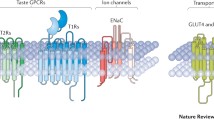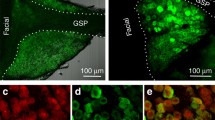Abstract
Taste buds endure extreme changes in temperature, pH, osmolarity, so on. Even though taste bud cells are replaced in a short span, they contribute to consistent taste reception. Each taste bud consists of about 50 cells whose networks are assumed to process taste information, at least preliminarily. In this article, we describe a neural network model inspired by the taste bud cells of mice. It consists of two layers. In the first layer, the chemical stimulus is transduced into an irregular spike train. The synchronization of the output impulses is induced by the irregular spike train at the second layer. These results show that the intensity of the chemical stimulus is encoded as the degree of the synchronization of output impulses. The present algorithms for signal processing result in a robust chemical-sensing system.
Similar content being viewed by others
References
Abeles M (1991) Corticonics. Cambridge University Press, Cambridge
Beidler LM (1970) Physiological properties of mammalian taste receptors. In: Wolstenholme GEW, Knight J (eds) Taste and smell in vertebrates. Churchill, London, pp 51–67
Braun HA, Wissing H, Schäfer K, Hirsch MC (1994) Oscillation and noise determine signal transduction in shark multimodal sensory cells. Nature 367: 270–273
Dando R, Roper SD (2009) Cell-to-cell communication in intact taste buds through ATP signalling from pannexin 1 gap junction hemichannels. J Physiol 587(24): 5899–5906
Douglass JK, Wilkens L, Pantazelou E, Moss F (1993) Noise enhancement of information transfer in crayfish mechnoreceptors by stochastic resonance. Nature 365: 337–340
Farbman AI (1980) Renewal of taste bud cells in rat circumvallate papillae. Cell Tissue Kinet 13: 349–357
Freund JA, Schimansky-Geier L, Beisner B, Neiman A, Russell DF, Yakusheva T, Moss F (2002) Behavioral stochastic resonance: how the noise from a daphnia swarm enhances individual prey capture by juvenile paddlefish. J Theor Biol 214: 71–83
Galán RF, Ermentrout GB, Urban NN (2006) Reliability, discriminability and stochastic synchronization of olfactory neurons. Sens Actuators B 116: 168–173
Huang YJ, Maruyama Y, Dvoryanchikov G, Pereira E, Chaudhari N, Roper SD (2007) The role of pannexin 1 hemichannels in ATP release and cell-cell communication in mouse taste buds. Proc Natl Acad Sci USA 104(15): 6436–6441
Izhikevich EM (2007) Dynamical systems in neuroscience. MIT Press, Cambridge
Kataoka S, Toyono T, Seta Y, Ogura T, Toyoshima K (2004) Expression of P2Y1 receptors in rat taste buds. Histochem Cell Biol 121: 419–426
Kimura K, Ohtubo Y, Kumazawa T, Yoshii K (2007) Electrophysiological identification of mouse taste bud cells. Int Congr Ser 1301: 254–257
Levin JE, Miller JP (1996) Broadband neural encoding in the cricket cercal sensory system enhanced by stochastic resonance. Nature 380: 165–168
Lindemann B (1996) Taste reception. Physiol Rev 76: 719–766
Moss F, Pierson D, O’Gorman D (1994) Stochastic resonance: tutorial and update. Int J Bifurc Chaos 4: 1383–1397
Nagai K, Nakao H (2009) Experimental synchronization of circuit oscillations induced by common telegraph noise. Phys Rev E 79: 036205
Nagai K, Nakao H, Tsubo Y (2005) Synchrony of neural oscillators induced by random telegraphic currents. Phys Rev E 71: 036217
Neiman AB, Russell DF (2002) Synchronization of noise-induced bursts in noncoupled sensory neurons. Phys Rev Lett 88(13): 138103
Noguchi T, Ikeda Y, Miyajima M, Yoshii K (2003) Voltage-gated channels involved in taste responses and characterizing taste bud cells in mouse soft palates. Brain Res 982: 241–259
Ohtubo Y (2007) Quantitative study on cell types in adult mouse taste buds. Int Congr Ser 1301: 250–253
Ohtubo Y (2009) Voltage-gated sodium currents of cell types in mouse taste bud cells. In: Abstract of The 7th international symposium on molecular and neural mechanisms of taste and olfactory perception, p 28
Ohtubo Y, Yoshii K (2011) Quantitative analysis of taste bud cell numbers in fungiform and soft palate taste buds of mice. Brain Res 1367: 13–21
Ohtubo Y, Suemitsu T, Shiobara S, Matsumoto T, Kumazawa T, Yoshii K (2001) Optical recordings of taste responses from fungiform papillae of mouse in situ. J Physiol 530: 287–293
Ohtubo Y, Hashiba Y, Kimura K, Kumazawa T, Yoshii K (2008) Voltage-gated Na+ currents of each cell type in mouse taste bud. In: Abstract of 18th congress of the European chemoreception research organization, p 83
Pikovsky A, Rosenblum M, Kurths J (2001) Synchronization. Cambridge University Press, Cambridge
Romanov RA, Rogachevskaja OA, Khokhlov AA, Kolesnikov SS (2008) Voltage dependence of ATP secretion in mammalian taste cells. J Gen Physiol 132(6): 731–744
Seta Y, Toyoshima K (1995) Three-dimensional structure of the gustatory cell in the mouse fungiform taste buds: a computer-assisted reconstruction from serial ultrathin sections. Anat Embryol 191: 83–88
Wilkens LA, Douglass JK (1994) A stimulus paradigm for analysis of near-field hydrodynamic sensitivity in crustaceans. J Exp Biol 189: 263–272
Author information
Authors and Affiliations
Corresponding author
Rights and permissions
About this article
Cite this article
Tateno, K., Igarashi, J., Ohtubo, Y. et al. Network model of chemical-sensing system inspired by mouse taste buds. Biol Cybern 105, 21–27 (2011). https://doi.org/10.1007/s00422-011-0447-5
Received:
Accepted:
Published:
Issue Date:
DOI: https://doi.org/10.1007/s00422-011-0447-5




